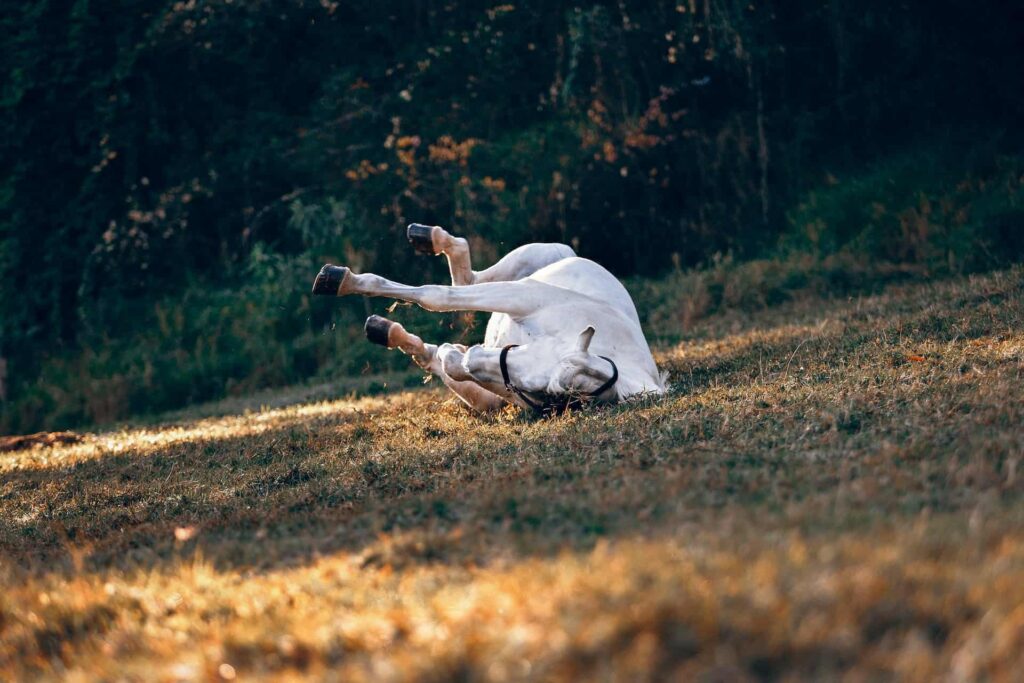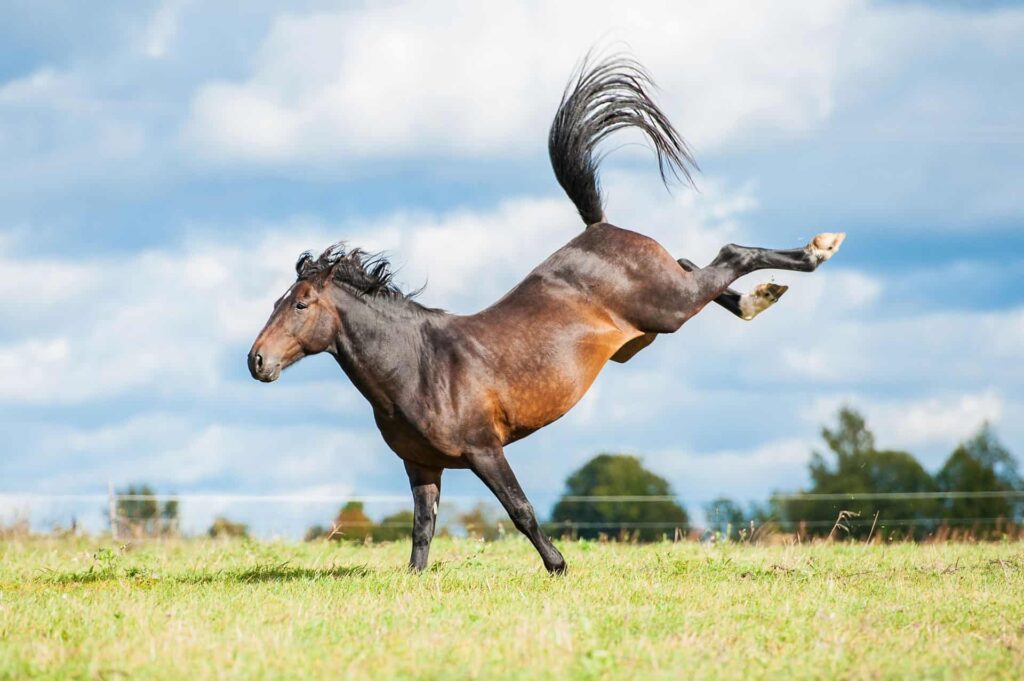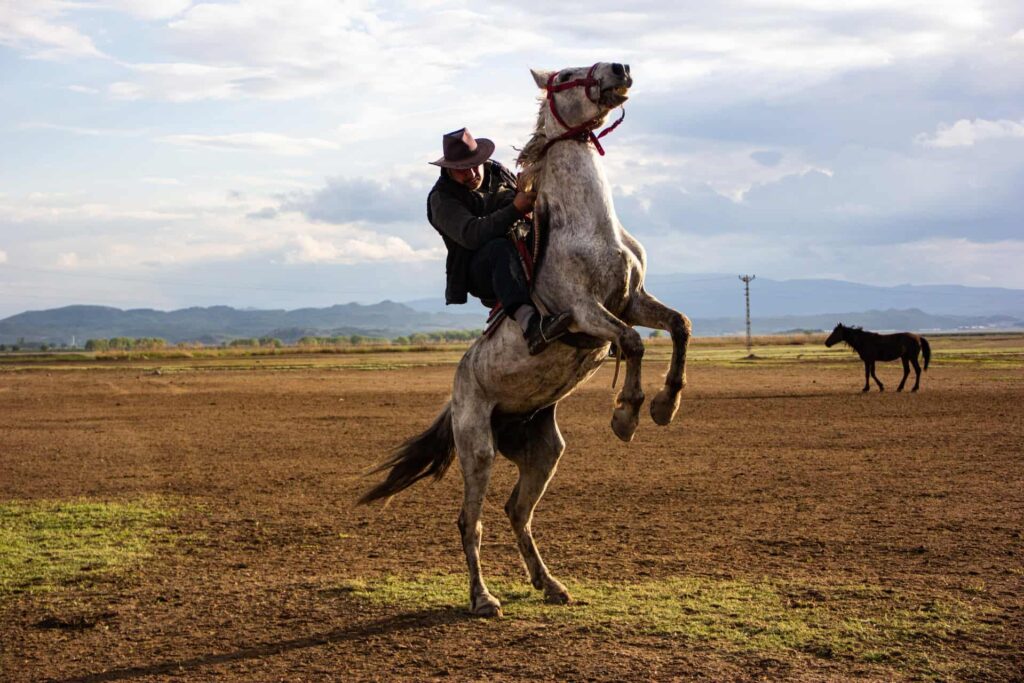Horses have a variety of behaviors that may seem curious to humans, and one of these is rolling in the dirt. This activity is actually a normal and sometimes necessary part of equine behavior. It serves several purposes, from grooming to comfort-seeking. While it may appear counterintuitive to see an animal roll in the dirt immediately after being cleaned, for horses, this behavior is instinctive and beneficial.
Rolling in the dirt helps horses to maintain their coat and skin health. The dirt acts as an exfoliant, removing dead skin and loose hair, and can also help to prevent parasites. Additionally, it’s a way for horses to cool down on hot days, as the layer of dirt can shield their skin from the sun and help to retain moisture, keeping them cooler. Rolling can also be a sign of a horse’s contentment and a way to stretch and relax their muscles.
Key Takeaways
- Rolling is a natural behavior for horses with multiple benefits, including grooming and cooling.
- The act of rolling in the dirt can be tied to a horse’s health, serving as both a physical aid and a means to prevent parasites.
- Observing a horse’s rolling behavior can offer insights into their well-being and comfort levels.
Understanding Equine Behavior
When horses roll in the dirt, they often participate in a behavior rich in communication and physical benefits. This action can serve multiple purposes including; social signaling, self-comfort, and even health maintenance.
Natural Behavior and Communication
Horses rolling in the dirt is considered a natural behavior that can facilitate communication among the herd. Dominant horses may roll to assert their dominance, while others might use this action to communicate with each other about their social status or comfort.
Indicators of Discomfort and Pleasure
Rolling can be an indicator of both discomfort and pleasure. While a horse rolling excessively or violently might be responding to pain or colic, a gentle roll often signifies relaxation and contentment.
Age and Gender Differences in Rolling
Observations suggest some variations where age and gender may influence a horse’s proclivity to roll. Younger horses might engage more frequently as a form of play, whereas older horses may roll for comfort or maintenance.
Rolling as Playful and Social Activity
Rolling often serves as a playful and social activity. Horses may use rolling to bond and interact with each other, turning this behavior into a fun group dynamic.
Responding to Environmental Factors
Horses can roll in response to environmental factors such as temperature and moisture. Rolling can help with cooling down or drying off by removing excess moisture. Additionally, dirt can act as sunscreen in summer or provide insulation against cold when they roll in snow.
Exercise and Stretching
Rolling can aid in exercise and stretching, helping to maintain muscle health and flexibility. Horses often use this behavior to stretch out their limbs and back, much like a yoga session for humans.
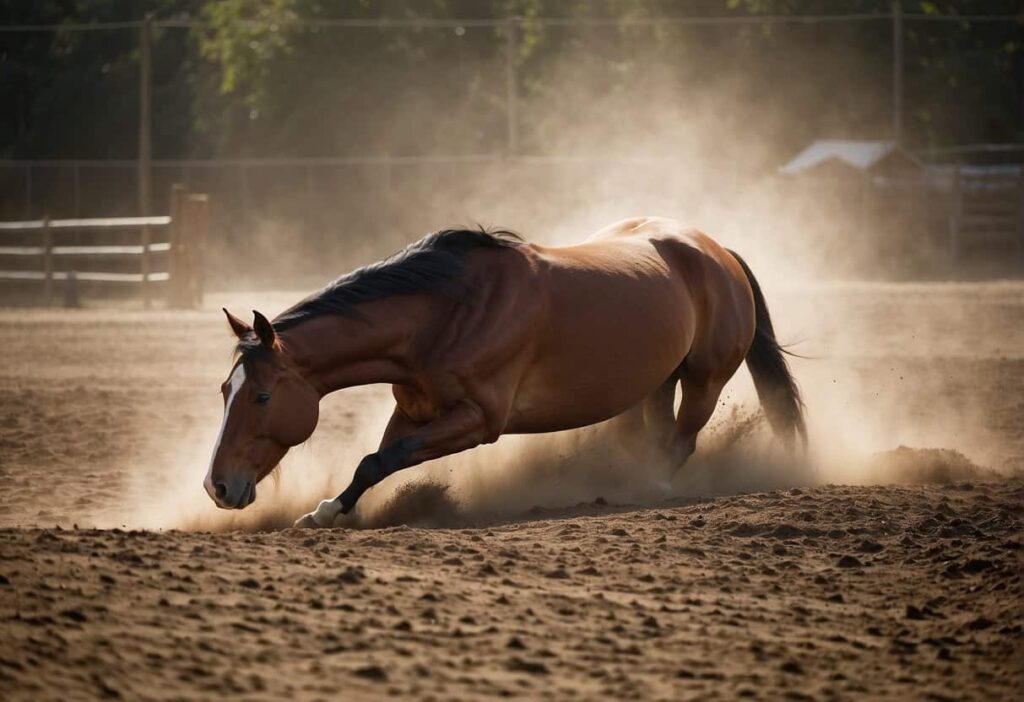
Health and Grooming
Horses roll in the dirt as part of their instinctual grooming behavior, helping them to manage skin health and pests, react to discomfort, and fulfill sensory needs.
Grooming and Self-Care
Horses perform self-grooming to maintain their coat and skin health. Rolling in the dirt or mud helps horses to remove loose hair, especially during shedding seasons. Moreover, the act serves as a self-massage that can release tension in the muscles.
Managing Parasites and Insects
Insects and parasites such as ticks and lice can be a nuisance to horses. A horse’s decision to roll in the dirt is a natural method to apply a layer that can deter pests or even physically remove them. Often, a bath or brushing by their caretakers complements this behavior, and the use of insect-repellent products can provide additional relief.
Identifying and Reacting to Illness
When a horse is itchy or experiencing skin conditions, rolling on the ground can be a way to relieve itching. Observant caretakers can interpret excessive rolling as a sign to check for potential illnesses and possibly consult a vet for targeted care.
Skin and Coat Maintenance
Rolling helps distribute natural oils across the horse’s coat, creating a protective barrier and enhancing its shine. Additionally, the act can aid in the shedding of the winter coat, ensuring the animal remains comfortable across seasons.
Sensory and Emotional Aspects
For horses, rolling is more than just physical upkeep. It allows them to scratch hard-to-reach places, provides sensory stimulation, and can be a display of emotions or dominance. This behavior contributes to a healthy horse‘s overall well-being, combining the sensory benefits with grooming and self-care practices.
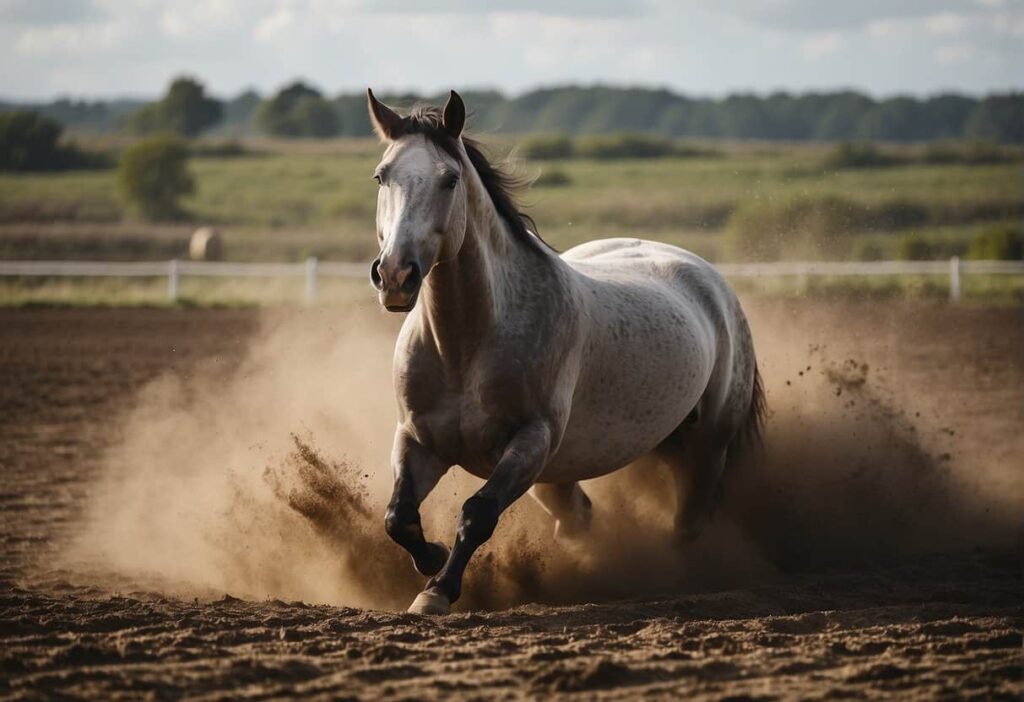
Equine Maintenance and Care
Maintaining a horse’s well-being involves providing them with suitable environments and care routines that accommodate their natural behavior, such as rolling. Rolling is an instinct for horses, serving various purposes like grooming, scratching, and even as a sign of relief or contentment.
Owner’s Role in Horse Care
Horse owners are responsible for understanding the natural behaviors of their equines, including the reasons why horses roll. Owners must ensure their horses have access to safe areas where they can exhibit this behavior without the risk of injury. Regular grooming and health checks can help in spotting any issues related to rolling, such as the accumulation of mud or grass on the horse’s coat, which can be indicative of parasites or skin conditions.
Facilities and Tools for Rolling
A safe rolling area is essential for equine care. Such an area should have safe fencing and be free of hazards like sharp objects or excessive moisture that could lead to mud accumulation and potential skin infections. Some horse owners provide specific rolling pits with sand or soft dirt, encouraging horses to roll in designated spots.
Preventing Injuries and Infections
To minimize the risk of injuries and infections, horse owners should ensure the rolling areas are clean and well-maintained. Overly wet conditions should be avoided to reduce the chance of bacterial and fungal infections. After rolling, a horse’s coat should be brushed to remove debris and to inspect for any signs of cuts or irritation.
Dietary Factors and Rolling Behavior
A horse’s diet can influence its rolling behavior. For example, discomfort after eating might prompt a horse to roll to alleviate the sensation. Owners should monitor their horse’s behavior closely, especially if the rolling occurs frequently after meals, as it may indicate dietary issues or digestive discomfort.
Understanding Different Rolling Surfaces
Different surfaces offer various benefits for horses when they roll. Grass provides a cleaner surface compared to mud or dirt, and is less likely to mat the horse’s coat or cause infections. Horse owners should observe their horses’ preferences, as they might change with the seasons or with the condition of their coats and skin.
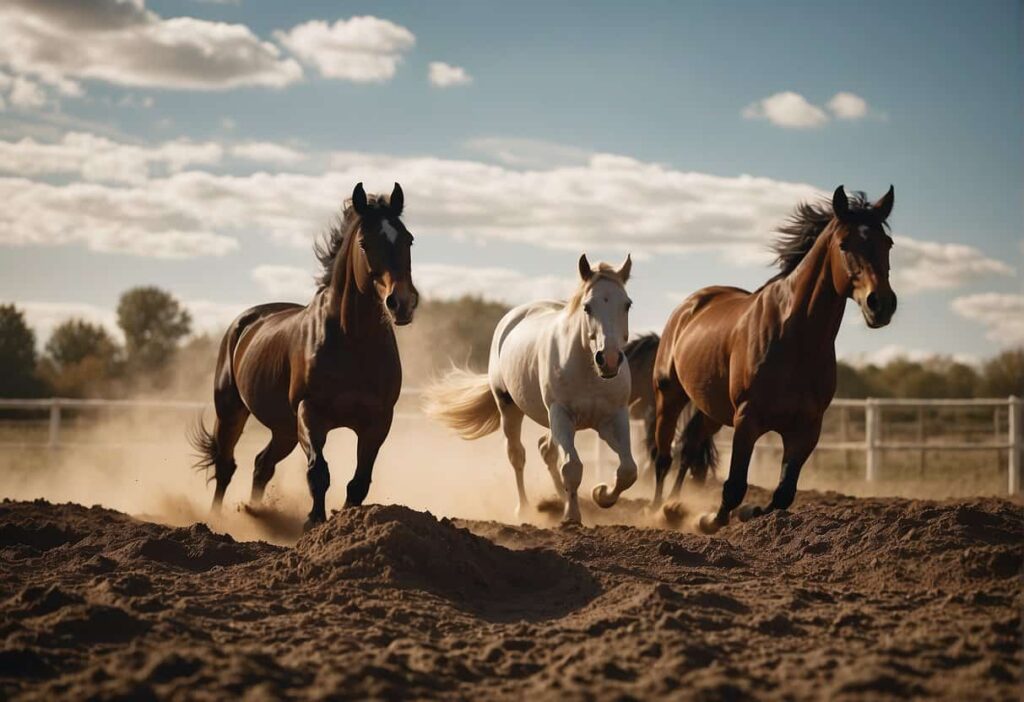
Social and Behavioral Dynamics
Horses engage in rolling as a multifaceted behavior influenced by social structure and interactive communication within a herd. This action is not merely a physical necessity but carries significant social connotations that vary from indicating dominance to fostering communal bonds.
Dominance and Hierarchy
In equine herds, the dominant horse may roll in the dirt to convey its dominance and maintain social order. This behavior is a visual indicator of their status, comfortably claiming space and asserting authority. Subordinate horses typically observe and wait for the dominant ones to finish before they engage in rolling themselves, respecting the established hierarchy.
Group Behavior and Communication
Group behavior in horses is not just about the hierarchy; it is also about communication and social bonding. Rolling can be a communal activity where horses interact and bond with one another. They may mimic others’ rolling behavior, demonstrating a form of social facilitation and reinforcing their connections. Horses rolling together can be a sign of a well-integrated and stable group dynamic, where communication is clear and relationships are well-established.
Frequently Asked Questions
Understanding why horses engage in certain behaviors is essential for their welfare and care. This section answers specific queries about horses rolling on the ground.
What are common reasons for horses rolling on the ground?
Horses roll in the dirt for various reasons, including to relieve themselves from skin irritations or to cool down. The behavior is also a natural way to care for their coat and may help in shedding hair or removing external parasites.
Can rolling be a sign of colic or other health issues in horses?
Rolling can indicate discomfort and is sometimes associated with colic, which is an abdominal pain in horses. Owners should observe the context and frequency, as persistent or violent rolling may necessitate prompt veterinary attention.
How should an owner respond if their horse rolls while being ridden?
If a horse attempts to roll while being ridden, the rider should immediately urge the horse to move forward and keep it walking. Allowing a horse to roll while being ridden can be dangerous and should be prevented to avoid injury to both horse and rider.
What does it indicate about a horse’s emotional state when it rolls after encountering a person?
When a horse rolls after meeting a person, it may suggest a relaxed and comfortable state. Rollings such as these can reflect a horse’s sense of security in its environment and with its handlers.
Is there a connection between horses digging or pawing the ground and their subsequent rolling behavior?
Horses often paw or dig at the ground before rolling to find a comfortable spot or to investigate the area. This prefatory action could be to ensure the surface is suitable for their rolling ritual.
Are there any effective methods to discourage horses from rolling during inappropriate times?
Deterring inappropriate rolling involves addressing the underlying reasons and ensuring horses have adequate opportunities to roll when safe. Strategies may include providing rolling spots, regular grooming, and avoiding situations that might encourage rolling, like placing tack on a hot and sweaty horse.
Last Updated on January 3, 2024 by Nate Dewsbury
